Have you ever wondered how tiny medical parts—like insulin pen components or IV catheter tips—are made with such consistent accuracy? Maybe you’re facing a design challenge for a new medical product and worry about finding a process that can flawlessly shape complex pieces. That’s where high precision injection molding comes in.
In short, precision injection molding is the process of using specialized molds and machinery to produce detailed plastic material parts with minimal variation. It helps by:
- Maintaining sterile conditions.
- Reducing production errors.
- Speeding up manufacturing process.
- Controlling material consistency.
In this article, we’ll explore how high precision injection molding supports medical device manufacturers, from design considerations to validation processes. We’ll look at standard equipment setups, mold material choices, and quality assurance procedures that make your parts trustworthy for patient use.
Medical Molding With High Precision Injection Molding
Medical devices require near-perfect accuracy. Even the slightest flaw can alter drug dosages or disrupt fluid flow. High precision injection molding steps up to the challenge by shaping complex geometries in high-volume production. By controlling every detail, manufacturers can ensure each piece meets strict regulatory standards and patient safety requirements.
Meeting Regulatory Demands
Since medical parts contact patients, compliance is non-negotiable. Precise molds help maintain consistent dimensions, ensuring devices pass regulatory audits. Without such accuracy, parts risk failing tolerance checks or receiving FDA rejections.
Material Reliability
Polymers in healthcare must be safe for bodily contact. When shaping them via precision injection molding, the process temperature and pressure remain tightly controlled. This preserves the polymer’s properties, preventing discoloration or brittleness.
Cost-Effective Quality
While molds and specialized machines might sound expensive, the long-term payoff is substantial. Producing medical parts in large volumes with minimal rejects ultimately saves money. Efficiency gains and reliable outcomes justify the upfront investment in precision molds.
Why Is Precision Injection Molding Essential In Healthcare?
The medical field demands reliability. A minor defect in a device can have serious consequences. That’s why high precision injection molding is so popular for items like insulin pens, IV components, and surgical instruments.
- Dimensional Stability: Parts must fit together securely to avoid leaks or contamination.
- Biocompatibility: Carefully selected plastics injection molding ensure safety when in contact with human tissue.
- Efficiency: Mass-producing error-free parts saves time and money.
Quick Tip: Always request material certifications from your molding partner to ensure biocompatibility and safety.
Cleanroom Requirements
Medical parts often need assembly or packaging in ultra-clean environments. This prevents contamination that could jeopardize patient safety. With high precision injection molding, it’s common to pair the process with an ISO-certified cleanroom. Here, special HVAC systems filter out dust and microbes.
Keeping contaminants out also protects the mold. Even tiny specks can alter shapes or textures, so a clean workspace is vital. Some facilities run fully enclosed conveyor lines from the molding machine to the packaging zone, sealing out external pollutants.
Mold Design And Selection
Think of the mold as the heart of high precision injection molding. Typically made from hardened steel, it must withstand thousands (or millions) of cycles without warping. Each cavity matches the exact shape of the finished part. This is why mold designers often use 3D Printing software to fine-tune every angle.
Quick Tip: Multi-cavity molds can mass-produce identical parts, boosting efficiency. However, having more cavities means each must be precise to avoid uneven filling or dimension shifts.
Engineers also incorporate gating systems that direct molten plastic into the mold. By positioning these gates carefully, they minimize air pockets and ensure uniform flow. Uniform flow, in turn, leads to consistent mechanical properties throughout the part.
Material Selection
A wide range of plastics suits medical applications, from polycarbonate to polypropylene. The choice depends on the device’s function—like clarity, flexibility, or chemical resistance. High precision injection molding demands stable materials that melt predictably and cool without excessive shrinkage.
Common medical-grade plastics:
- Polycarbonate (PC) for transparent housings
- Polypropylene (PP) for syringes
- Polyethylene (PE) for tubing
- Acrylonitrile Butadiene Styrene (ABS) for durable enclosures
Before molding, each resin batch is tested for moisture content and purity. This prevents nozzle clogs or part defects. Once verified, the resin goes into the hopper, melts in the barrel, and is injected under high pressure into the mold.
Process Control Techniques
During high precision injection molding, operators control temperature zones in the barrel and mold precisely. Pressure profiles are also carefully timed to avoid sink marks or flashing. Real-time sensors might track injection pressure or part ejection force, providing immediate feedback.
Some machines come with advanced software that automatically adjusts parameters if it senses variation in melt viscosity or ambient conditions. This closed-loop control helps maintain consistency across production runs, preventing random spikes in part dimension changes.
Validation And Quality Checks
Once a run is complete, high-precision metal parts typically undergo inspection. This might include dimensional checks using high-resolution cameras or coordinate measuring machines. Biocompatibility testing ensures the plastic won’t release harmful substances. Manufacturers often keep strict documentation to align with FDA or ISO requirements.
Validation steps for high precision injection molding usually include:
- First article inspection.
- Process capability analysis.
- Sterilization compatibility tests.
- Ongoing sampling.
- Packaging and labeling verifications.
Any deviation spotted early can be traced back to the process parameters or mold conditions. Quick corrective actions might mean adjusting injection speed or refining cooling times. The goal is to maintain a stable, proven process from start to finish.
Table: Common Challenges And Solutions
Below is an overview of frequent hurdles in high precision injection molding for medical devices, along with potential remedies:
| Challenge | Cause | Solution |
|---|---|---|
| Dimensional Drift | Mold wear or temp fluctuations | Use hardened steel, maintain a stable process |
| Flashing | Excessive injection pressure | Adjust clamp force, refine gating strategy |
| Sink Marks | Inadequate packing pressure | Optimize holding time, increase pack pressure |
| Short Shots | Insufficient fill or partial clog | Check vents, clean nozzle or manifold |
| Warping | Uneven cooling | Balance cooling lines, uniform part design |
Consistent part geometry hinges on nailing each parameter. Teamwork between mold designers, machine techs, and quality engineers ensures robust solutions.
Conclusion
Ultimately, high precision injection molding provides the reliability, speed, and accuracy that medical device manufacturing demands. From plastic syringes to sophisticated implant components, this injection molding technology shapes our healthcare landscape. Its ability to maintain ultra-tight tolerances is what sets it apart from standard molding methods.
If your business requires large volumes of high-grade medical parts, turning to precision injection molding can revolutionize your production cycle. Once the molds and processes are validated, you’ll enjoy the predictability and cost savings of a proven technique designed for some of the world’s most critical applications.
FAQs
How is high precision injection molding different from regular injection molding?
It uses more advanced molds and tighter process controls to achieve extremely narrow tolerances, which is crucial in medical applications.
What materials are typically used?
Medical-grade plastics such as polypropylene, polycarbonate, and polyethylene are commonly selected for their biocompatibility and stability.
Can I produce complex shapes with high precision injection molding?
Yes. The process supports intricate features like undercuts or thin walls as long as the mold and injection parameters are carefully designed.







